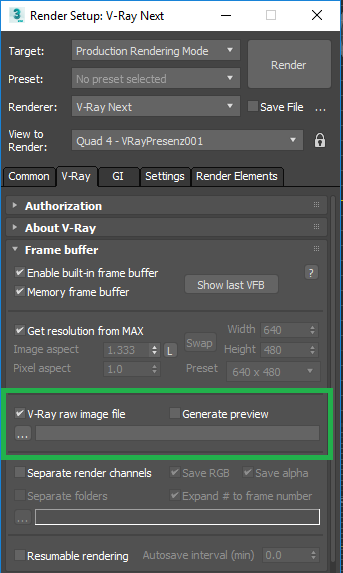Rendering With PresenZ¶
Output Render Path¶
Before rendering, you should specify the exact path to where you want to save the .PRZ file. In the 3ds Max Render Setup menu go to the Vray tab and under Frame Buffer enable the Vray raw image file checkbox. Input the full file path, for example “C:\path\to\renders\yourFileName.prz”.
PresenZ will also create a przDetect and przRender folder at that location. These folders are used to store intermediate files generated by the PresenZ two phases system.

Rendering and merging¶
To render you image, select the PresenZ render button.

In case you forgot to set certain settings such as setting the render engine to Vray, enabling bucket rendering, and creating a PresenZ camera, PresenZ will give you the option to automatically change these settings.
Warning
Be sure to have properly set your output location, as explained in the previous section.
Once everything is setup properly you will see the PresenZ render window as illustrated below
- Zone of View: allows you to select which Zone of View you are going to render (Since you can have several in your 3D Scene).
- Merge files after rendering: On by default. This will automatically start the merger after completing the different phases of the rendering process. Alternatively, you can manually merge your output files through the command line. This is explained in the PresenZ Utility Merger section.
- Render button: This button will automatically launch the different PresenZ render phases, one after the other.
- Merge button: This button allows you to manually re-merge your .przRender files after they have been rendered.
Note
The merge button is useful to apply your Vray Frame Buffer Color Correction Settings without having to re-render.
- Progress bar: Depending on the options the whole PresenZ render will take several phases and possibly passes (for instance opaque and glass passes). This will show you the progress in those phases/passes.
Underneath the progress bar a number will indicate how many passes will be executed for your render, this number can change. For a normal render this number will be 3: a detection pass, a render pass, and the merge.
As another example, if you have decided to render in “opaque and glass” mode the whole PresenZ render will take more passes than a standard render. The total number of passes will be 5: one detection pass and render pass for the opaque objects, one detection and render pass for the transparent objects, and a final merge.